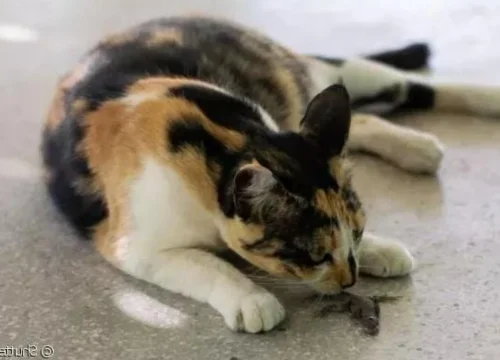Feline Platinosomiasis: A Comprehensive Look at Causes, Symptoms and Treatments
Feline Platinosomosis, also known as Tritrichomonas foetus, is a parasitic infection that affects the intestines of cats. Although it's a relatively rare condition, it's important to understand its symptoms, diagnosis and treatment options to ensure the well-being of our feline friends. In this article, we'll explore in detail everything you need to know about Feline Platinosomosis.
Understanding Gecko Disease and How to Deal with It
Feline Platinosomiasis, also known as Tritrichomonas foetus, is a condition that is sometimes popularly referred to as "gecko disease". This nickname is due to the fact that cats can contract the infection by hunting or eating infected lizards. While it is important to understand the technical terms associated with the disease, it is also useful for cat owners to understand the relationship between Feline Platinosomosis and their feline's hunting behavior.
Contents
What is Feline Platinosomiasis?
Feline Platinosomiasis is a disease caused by the parasite Tritrichomonas foetus, which mainly affects the large intestine of cats. This parasite is transmitted mainly through fecal-oral contact, either directly between cats or through contaminated objects. Young cats, especially those living in multi-cat environments such as shelters or breeding grounds, are more susceptible to infection.

Causes and Transmission
The main cause of Feline Platinosomiasis is infection by the parasite Tritrichomonas foetus. Transmission occurs when a cat comes into contact with the contaminated feces of an infected cat. This can happen in situations where litter boxes are shared, direct contact between cats or contact with contaminated surfaces.
Feline Platinosomiasis, also known as Tritrichomonas foetus, is a condition that is sometimes popularly referred to as "gecko disease". This nickname is due to the fact that cats can contract the infection by hunting or eating infected lizards.
Symptoms of Feline Platinosomiasis
Symptoms of Feline Platinosomiasis can vary in severity and may include:
- Chronic diarrheaPersistent diarrhea is one of the most common symptoms of Feline Platinosomiasis. Diarrhea can be liquid, bloody or mucous, and can occur intermittently over time.
- Weight lossDue to chronic diarrhea and difficulty absorbing nutrients from food, cats with Feline Platinosomosis may experience significant weight loss.
- DehydrationFrequent diarrhea can lead to dehydration, especially if not treated properly.
- Abdominal discomfortSome cats may show signs of abdominal discomfort, such as vocalization during defecation or sensitivity to touch in the abdominal region.
It's important to carefully observe any changes in your cat's behavior or bowel habits and report any symptoms to your vet.
Diagnosis and treatment
Diagnosis usually involves a combination of physical examinations, analysis of fecal samples and specific laboratory tests to detect the presence of the parasite Tritrichomonas foetus. If Feline Platinosomosis is suspected, your vet may recommend DNA tests or fecal culture to confirm the diagnosis.
Treatment of Feline Platinosomiasis can be challenging and involves a combination of approaches, including specific drugs to eliminate the parasite, supportive therapy to relieve symptoms and measures to prevent the spread of the infection to other cats.
Prevention and Control
Although Feline Platinosomiasis can be difficult to prevent completely, there are some measures that cat owners can take to reduce the risk of infection:
- Keep the sandbox clean: Clean your cat's litter box regularly to reduce the chance of fecal contamination.
- Avoid Contact with Infected CatsIf you have multiple cats in your home, keep infected cats isolated from healthy cats and avoid sharing litter boxes, feeders and drinkers.
- Hand hygieneAlways wash your hands after handling cat feces or after contact with infected cats.
- Regular Veterinary Visits: Have your cat's health checked regularly and follow the vet's recommendations for parasite prevention.
Post-treatment management and monitoring
After treatment for Feline Platinosomiasis, it is important to monitor your cat closely to ensure a full recovery and prevent recurrences of the infection. Your vet may recommend scheduling follow-up appointments to check the effectiveness of the treatment and monitor any signs of re-infection.
During the post-treatment period, watch your cat closely for any signs of symptoms returning, such as persistent diarrhea, weight loss or abdominal discomfort. Also, make sure to maintain litter box hygiene and practice good hand hygiene to reduce the risk of re-infection.
Conclusion
It is a condition that can affect the health and well-being of cats, causing uncomfortable symptoms and impairing quality of life. With a proper understanding of the causes, symptoms and treatment options available, cat owners can help prevent, diagnose and treat Feline Platinosomiasis effectively.
If you suspect that your cat may be infected with Feline Platinosomiasis or if it shows worrying symptoms, it is essential to seek immediate veterinary advice. With proper care and intervention, it is possible to help your cat recover and enjoy a happy and healthy life.
You may be interested in, Seizures in Cats: Causes, Symptoms and Treatments








